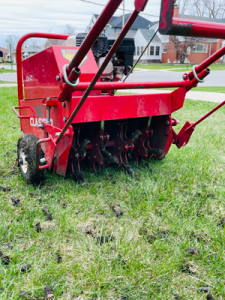Here are some reasons I think we should not wait till spring to give attention to our lawns and gardens.
First, they say “April showers bring May flowers.” But, it might help if you’ve done some October planting of spring flowering bulbs. So, in early spring when you see the potted hyacinths, tulips and daffodils at Jewel or Mariano’s and wished you had some of those beauties coming up in your garden, it’s too late! You have to think spring in the fall.
After a long summer, your cool-weather bluegrass and fescue turf can look pretty beat up by all the heat, drought, sports and parties. But, instead of thinking the season’s over and waiting until spring to get it back into shape, you should be taking advantage of the most useful time of year for the health of your lawn. There are two reasons doing lawn repair in the fall is better than the spring. Spring is when you deal with crabgrass problems and other annual weeds. But, when you or your lawn-care professional applies a spring pre-emergent treatment, it will do as good a job at keeping your grass seed from germinating as it does preventing the crabgrass and other weed seed from sprouting. Secondly, if you seed bare spots or thin areas of your lawn in the fall, you will have two cool seasons conducive for growth and establishment before the challenges of summer heat come. When you have seeded in the fall, the bright green of those grass seedlings will already be covering those bare spots in your yard in late March. So, when it comes to seeding, think spring in the FALL!
 Fall is also a better time than spring for aerating your lawn because the lawn will have more time to recover before summer heat and droughts. Too, in spring you don’t want to perforate your pre-emergent barrier or open up your soil, making it easier for weed seed to germinate and for your lawn to dry out. So, for lawn aeration too, you should think spring in the fall.
Fall is also a better time than spring for aerating your lawn because the lawn will have more time to recover before summer heat and droughts. Too, in spring you don’t want to perforate your pre-emergent barrier or open up your soil, making it easier for weed seed to germinate and for your lawn to dry out. So, for lawn aeration too, you should think spring in the fall.
One last thing to consider is that planting and transplanting perennials and shrubs is better done in the fall than the spring. There might even be an extra incentive if your local nursery or garden center marks down its stock for clearance. New plantings and transplants need moist soil to encourage the expansion of their root systems. The cool temperatures and possibly more rainfall in fall and spring means less watering is needed and it’s easier for the soil to retain moisture. So, when you plant new or divide and transplant your long time perennials in the fall, they will have two seasons that will encourage root establishment without you having to worry much about watering.
Are you convinced yet that it’s better to think spring in the fall?
